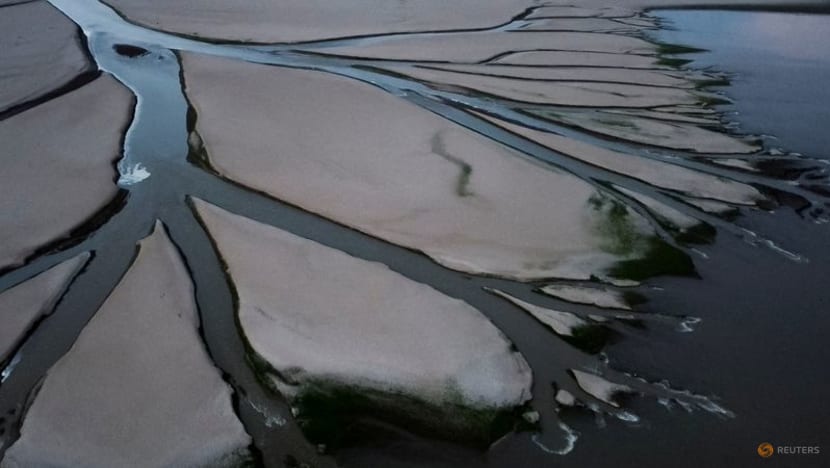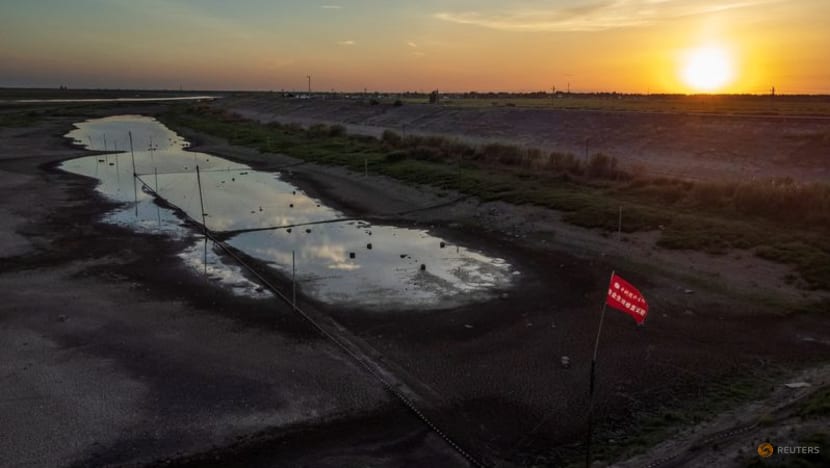
An aerial view shows a tributary stream running through the dried-up flats of Poyang Lake that stands at record-low water levels as the region experiences a drought, outside Nanchang, Jiangxi province, China on Aug 28, 2022.
23 Sep 2022
SHANGHAI: The central Chinese province of Jiangxi has declared a water supply "red alert" for the first time after the Poyang freshwater lake, the country's biggest, dwindled to a record low, the Jiangxi government said on Friday (Sep 23).
The Poyang Lake, normally a vital flood outlet for the Yangtze, China's longest river, has been suffering from drought since June, with water levels at a key monitoring spot falling from 19.43m to 7.1m over the last three months
The Jiangxi Water Monitoring Centre said Poyang's water levels would fall even further in coming days, with rainfall still minimal. Precipitation since July is 60 per cent lower than a year earlier, it said.
As many as 267 weather stations across China reported record temperatures in August, and a long dry spell across the Yangtze river basin severely curtailed hydropower output and damaged crop growth ahead of the autumn harvest.

Related:

Receding water levels of China's Yangtze reveal ancient Buddhist statues

In pictures: China hit by drought as record heatwave continues
Though heavy rain has relieved the drought in much of southwest China, central regions continue to suffer, with extremely dry conditions now stretching more than 70 days in Jiangxi.
A total of 10 reservoirs in neighbouring Anhui province have fallen below the "dead pool" level, meaning they are unable to discharge water downstream, the local water bureau said earlier this week.
State weather forecasters said this week that drought conditions still prevailed in the middle and lower reaches of the Yangtze, and efforts were required to seed clouds and divert water from elsewhere.
23 Sep 2022
SHANGHAI: The central Chinese province of Jiangxi has declared a water supply "red alert" for the first time after the Poyang freshwater lake, the country's biggest, dwindled to a record low, the Jiangxi government said on Friday (Sep 23).
The Poyang Lake, normally a vital flood outlet for the Yangtze, China's longest river, has been suffering from drought since June, with water levels at a key monitoring spot falling from 19.43m to 7.1m over the last three months
The Jiangxi Water Monitoring Centre said Poyang's water levels would fall even further in coming days, with rainfall still minimal. Precipitation since July is 60 per cent lower than a year earlier, it said.
As many as 267 weather stations across China reported record temperatures in August, and a long dry spell across the Yangtze river basin severely curtailed hydropower output and damaged crop growth ahead of the autumn harvest.

An aerial view shows a dried up fish habitat experimentation farm at Poyang Lake that stands at record-low water levels as the region experiences a drought, outside Nanchang, Jiangxi province, China on Aug 26, 2022.
Related:

Receding water levels of China's Yangtze reveal ancient Buddhist statues

In pictures: China hit by drought as record heatwave continues
Though heavy rain has relieved the drought in much of southwest China, central regions continue to suffer, with extremely dry conditions now stretching more than 70 days in Jiangxi.
A total of 10 reservoirs in neighbouring Anhui province have fallen below the "dead pool" level, meaning they are unable to discharge water downstream, the local water bureau said earlier this week.
State weather forecasters said this week that drought conditions still prevailed in the middle and lower reaches of the Yangtze, and efforts were required to seed clouds and divert water from elsewhere.
No comments:
Post a Comment